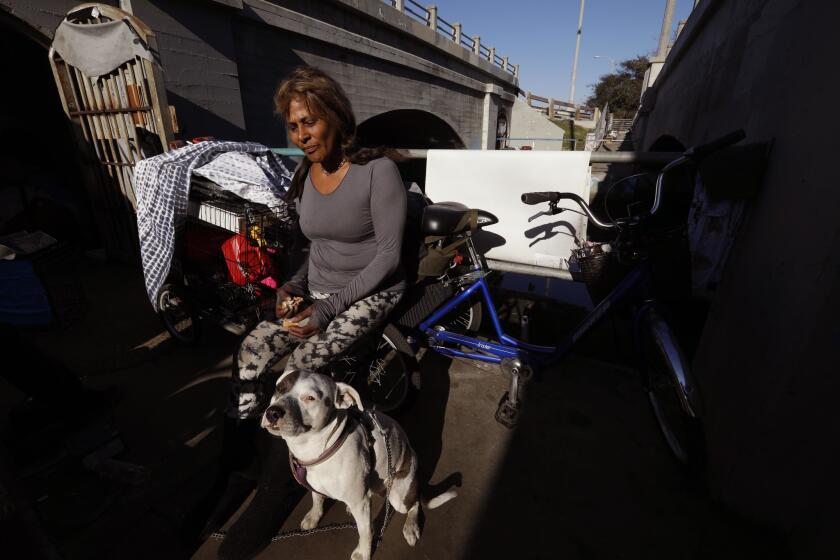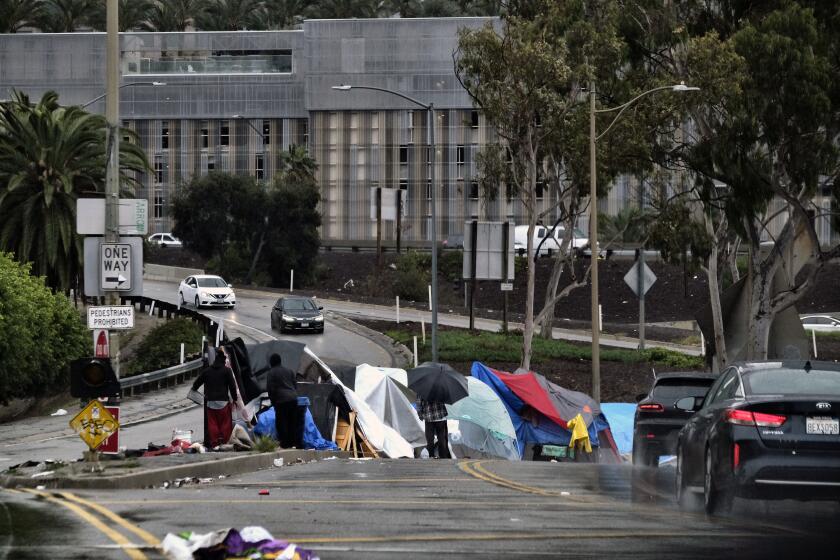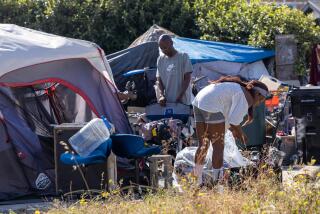Editorial: Leasing permanent housing for homeless people is faster than building it

- Share via
As soon as Karen Bass became mayor of Los Angeles, she created a program called Inside Safe, dedicated to moving homeless people from the street into interim housing.
In the seven months since it was launched in late December, 1,463 people living on the street moved inside, mostly into motel rooms.
By the end of July, 250 had left their Inside Safe housing, mostly to return to the streets. Of that number, four were in medical or psychiatric facilities, three were incarcerated and six had died. The whereabouts of some are unknown.
A total of 83% remain in the temporary housing of Inside Safe. It’s disappointing that it’s not more, but people fall out for all sorts of reasons, and some people left because they didn’t like some of the rules. Some motels and hotels in the program have rules — put in place by service providers — that residents chafe at following.
Mayor Karen Bass wants to fast-track homeless housing. So why is the city slow-walking a project in Venice?
For example, the Weingart Center, which provides services at the L.A. Grand, doesn’t allow residents to have nonresident visitors in their rooms. Va Lecia Adams Kellum, the chief executive of the L.A. Homeless Services Authority, says that having residents and service providers create the rules together could help keep people in housing.
The more concerning number is how few people — just 108 — have moved into permanent housing. That is the ultimate goal — and the only thing that turns a homeless person into a housed person.
Offering people interim housing through programs such as Inside Safe is important and worth continuing. But it’s incredibly costly. People are staying in motels and hotels for half a year, and many may stay as long as a year before they find a permanent place to live, based on past experience with temporary housing, says Adams Kellum. We need more permanent housing projects for homeless people even though the projects are slow to develop and expensive to build.
Meanwhile, many homeless people already have long-term housing vouchers or limited time subsidies (intended to last two years or sometimes longer) but can’t find an available apartment that is affordable or which a landlord is willing to rent. Although landlords cannot legally refuse to rent to someone just because they have a voucher, they do turn down applications from homeless people for other reasons, such as poor credit or lack of rental history.
One smart way to get around these obstacles and house people relatively quickly is to lease entire apartment buildings or several units in buildings under one lease agreement or master lease. In these cases, the city or a nonprofit organization rents the units, taking the reluctant landlord out of the equation and housing the people who desperately need it.
Why haven’t all our efforts paid off yet? Several years of time and investment can’t begin to fix the underlying systemic problems that bedevil us.
This has already been done to some degree by nonprofits. The People Concern, a nonprofit that provides services to 72 people in two Inside Safe motels, also master-leases about 100 units in four buildings and is talking to two other landlords about another 100-some units. “If we were able to get them all we would clear our motels and take more people,” says John Maceri, the chief executive of the organization.
It’s time to scale up master leasing to get more people housed faster.
The Los Angeles Homeless Services Authority, smartly, is doing just that.
Adams Kellum says her agency has commitments from owners of various buildings to lease 300 units for which the People Concern and the Homeless Outreach Program Integrated Care System, or HOPICS, will provide services. Adams Kellum’s goal is to master-lease a total of 800 units by June. Also, the faster people move into apartments, the faster those still on the street can take their place in hotels and motels.
Under its master leasing program, LAHSA will be able to provide rental subsidies and services for residents through Measure H funds. Also, LAHSA will take over property management of these units (another incentive for a landlord to agree to master leasing) covering damage to units and other costs. The funding for that will come from the state’s Housing and Homelessness Incentive Program — which are Medi-Cal dollars funneled through the managed-care agencies, L.A. Care and Health Net.
As of last week, 15 people from an Inside Safe motel have moved into their own units in master-leased buildings in South L.A. This is a promising start. Master-leasing permanent housing is faster than building it from the ground up and cheaper than expanding the number of hotel and motel rooms being rented.
However, this approach can’t end homelessness. The city needs to continue to invest in financing and to help develop permanent housing for homeless people. Only more housing will make a dent in this crisis.
More to Read
A cure for the common opinion
Get thought-provoking perspectives with our weekly newsletter.
You may occasionally receive promotional content from the Los Angeles Times.












